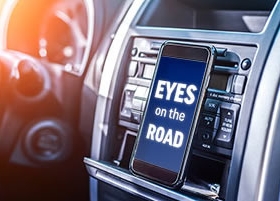Article at a Glance
- Teen drivers, already a high-risk group, are 23 times more likely to crash when texting.
- Parents can help by talking about the risks, modeling good behavior, defining a teen driving contract and using technological blocks.
As parents, we worry about teens driving distracted—with good reason. Texting while driving multiplies the risk of an accident by twenty-three times. And that’s on top of the already elevated risk inherent to being a teen driver.
The facts
- In 2011 at least 23% of auto collisions involved phone use.
- While there are many kinds of distracted driving, texting is especially dangerous because it distracts the eyes, the brain, and the hands.
- Sending a text distracts for at least five seconds. At 55mph, this means your teen could travel the length of a football field without looking up.
- 77% of young adults report being very or somewhat confident they can safely text while driving.
- According to the CDC, the biggest threat to teen life is driving or riding with another teen driver.
- Most states have laws against texting and driving. Utah law bans texting while driving for all drivers and bans all cell phone use for drivers under eighteen.
How to get through to your kids
Statistics like those above raise parental eyebrows but will have a limited effect on teens. Getting through to your teen may require a multi-faceted approach.
Model good driving habits
The surest way to teach our children anything is by being a good example, even—or especially—if your children are years away from getting behind the wheel.
- Make a point of putting your phone away in your purse or glove box when you buckle up.
- Point out other distractions that come up on the road and explain that you can’t reach for that toy, read them a book, or change the music because it’s important you keep your focus on driving.
- Model good passenger behavior and speak up if someone is texting while driving.
- Keep safety at the center of all your conversations about texting and driving and explain that cell phone use is a privilege—not a need—and that it comes second to our safety and the safety of others.
Make a family commitment
If you haven’t been a perfect example, you’re not alone. Forty-eight percent of young drivers have seen their parents text and drive. To make a fresh start, consider having every driver in the family take a pledge not to drive distracted.
- You can write your own pledge or download one from the National Safety Council.
- Frame and hang the signed pledge wherever your family hangs their keys.
Write a driving contract
A teen driving contract can be a helpful tool in the fight against distracted driving.
- Contracts typically define the teen’s responsibilities such as following traffic laws, never driving intoxicated and not texting while driving.
- Consequences for violating the contract can also be outlined.
- Some agreements even include commitments from Mom and Dad, such as no-questions-asked pickups if the teen finds himself in a situation when he is not safe to drive.
You can write your own contract or download one from many non-profit and government websites.
Technology safety-nets
If you’re still worried your teen may be texting while driving there are a few technological resources for parents.
- Apps such as AT&T Drive Mode, DriveSafe.ly and Textecution offer ways to prohibit texting and driving by detecting the user’s speed via GPS.
- Many easy-to-install driver monitoring cameras are on the market.
Like any behavior we wish to teach our children, we get the best results when we set clear expectations and consequences and when we lead by example.
For more information:
New Law Banning Cell Phone Use For Teen Drivers Goes Into Effect
Summer brings 100 deadliest days of the year
Share this article:
